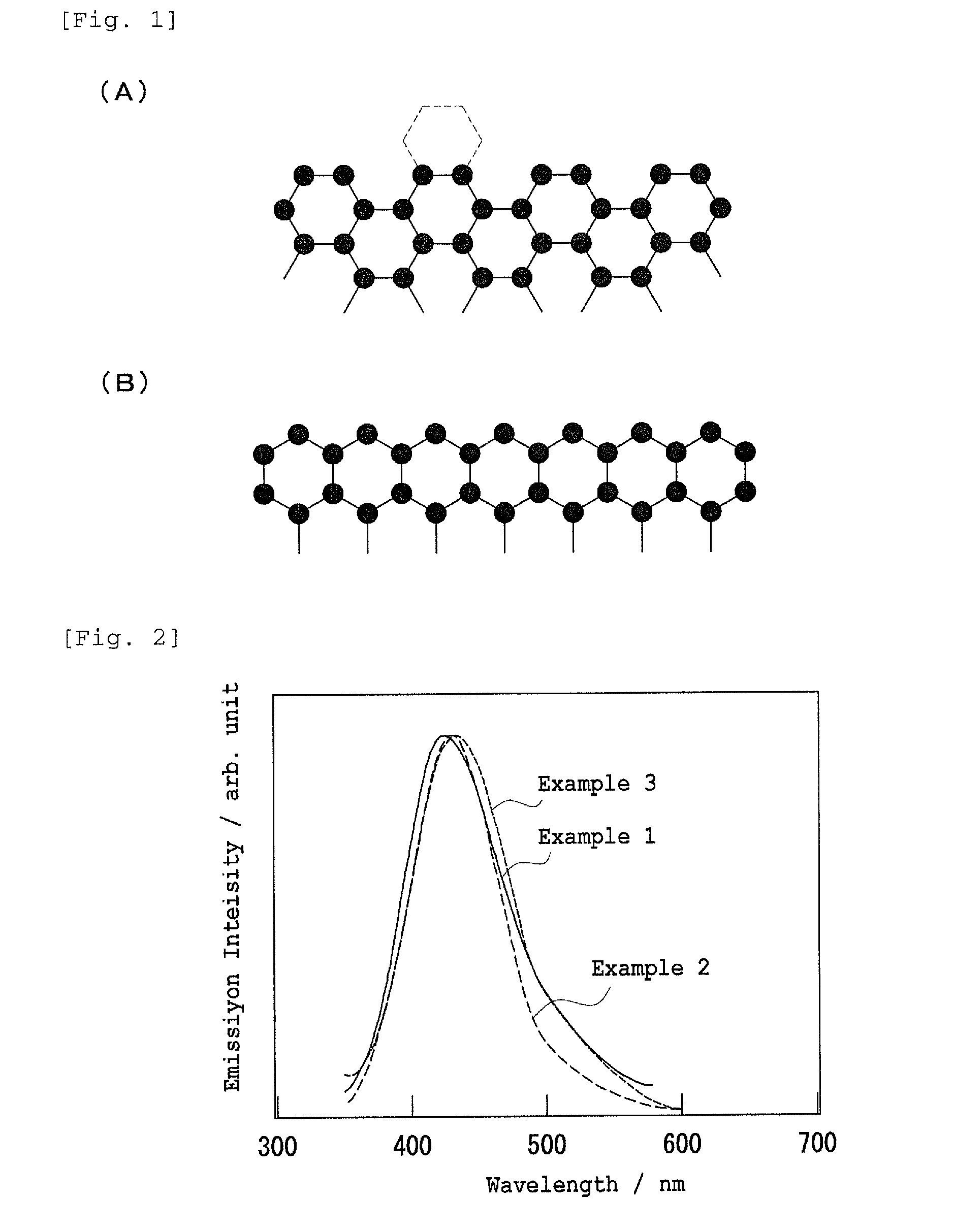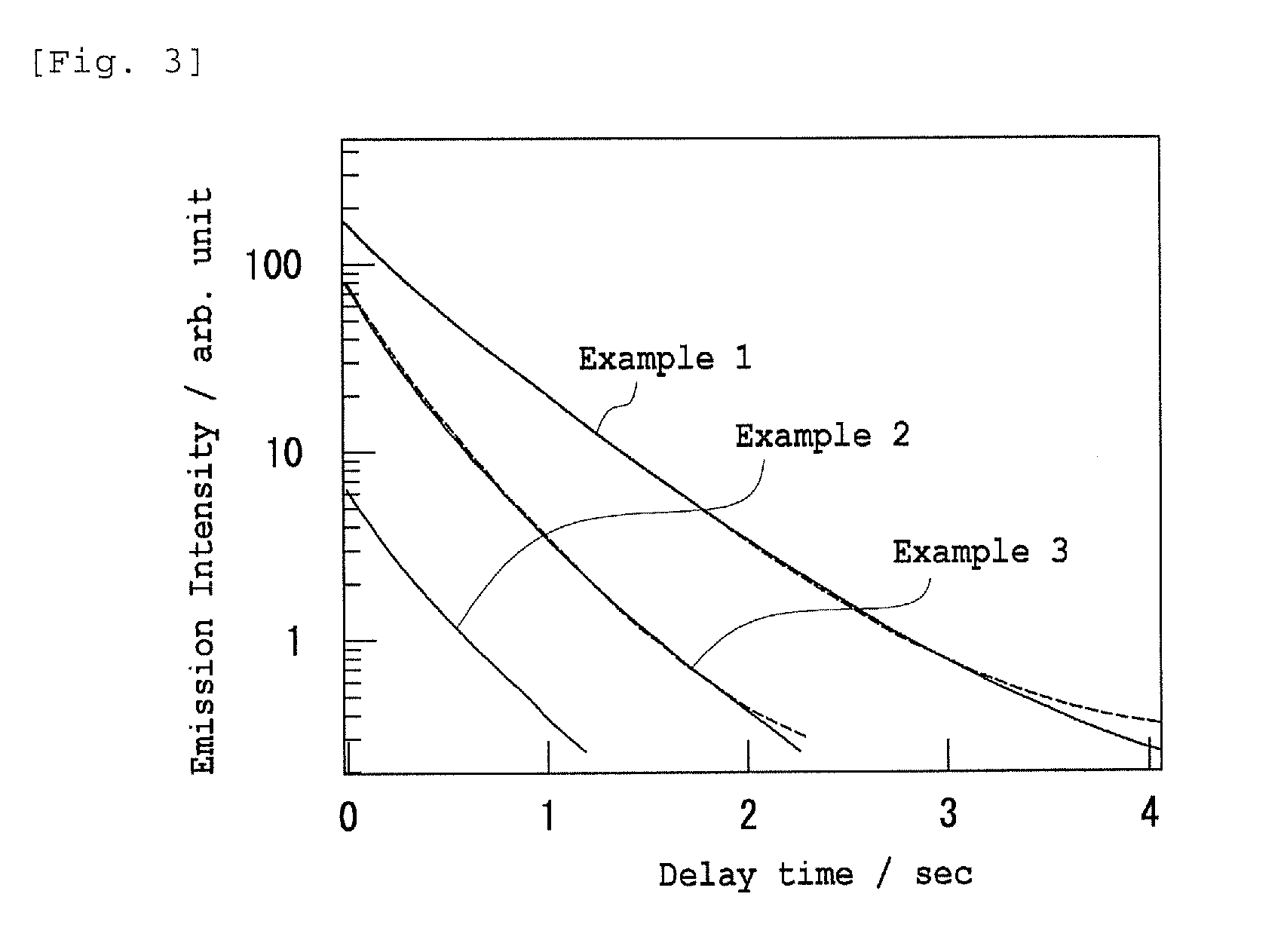Light emitting body
a technology of light-emitting bodies and carbon phosphors, which is applied in the field of light-emitting bodies, can solve the problems of short emission lifetime of carbon phosphors available by conventional methods, and achieve the effects of short emission lifetime, low emission efficiency and emission lifetim
- Summary
- Abstract
- Description
- Claims
- Application Information
AI Technical Summary
Benefits of technology
Problems solved by technology
Method used
Image
Examples
example 1
1. Preparation of Phosphor Dispersion
[0209]Graphite oxide (0.1 g) was dispersed in 5 mL of a 0.2 mol / l aqueous urea solution. The aqueous solution thus obtained was heated at 150° C. for 10 hours in a hermetically sealed container. After heating, the solution was washed sufficiently to separate a nitrogen-containing graphene structure.
[0210]Next, 10 mg of polyacrylic acid (covering material) was dissolved in 5 mL of an aqueous dispersion having 0.1 mg of the nitrogen-containing graphene structure dispersed therein. The solution thus obtained was dried to yield a nitrogen-containing graphene structure / polyacrylic acid composite.
2. Test Method
[2.1. Emission Spectrum]
[0211]Emission spectrum of a light emitting body was measured using a spectrofluorometer (“FP-6500”, trade name; product of JASCO).
[2.2. Emission Efficiency]
[0212]Emission efficiency was measured using an absolute photo-luminescence quantum yield measurement system (“C9920-02”, trade name; product of Hamamatsu Photonics).
[...
example 2
1. Preparation of Sample
[0215]In a similar manner to Example 1 except for the use of carboxymethyl cellulose as the covering material, a nitrogen-containing graphene structure / carboxymethyl cellulose composite was obtained.
2. Test Method
[0216]Under similar conditions to those in Example 1, emission spectrum, emission efficiency, and emission lifetime were measured.
3. Results
[0217]Results are shown in FIG. 2, FIG. 3, and Table 1. The light emitting body obtained in Example 2 had a peak position of the spectrum at 433 nm and the half width of the peak was 90 nm. In addition, the light emitting body had emission efficiency of 21%, which was markedly higher compared with Non-patent Document 1. It had an emission lifetime of 0.47 second, revealing that it had a very long emission lifetime.
example 3
1. Preparation of Sample
[0218]In a similar manner to Example 1 except for the use of polyvinyl alcohol as the covering material, a nitrogen-containing graphene structure / polyvinyl alcohol composite was obtained.
2. Test Method
[0219]Under similar conditions to Example 1, emission spectrum, emission efficiency, and emission lifetime were measured.
3. Results
[0220]The results are shown in FIG. 2, FIG. 3, and Table 1. The light emitting body obtained in Example 3 had a peak position of the spectrum at 430 nm and the half width of the peak was 78 nm. In addition, it had emission efficiency of 23%, which was markedly higher compared with Non-patent Document 1. It had an emission lifetime of 0.38 second, revealing that it had a very long emission lifetime.
PUM
| Property | Measurement | Unit |
|---|---|---|
| size | aaaaa | aaaaa |
| size | aaaaa | aaaaa |
| size | aaaaa | aaaaa |
Abstract
Description
Claims
Application Information
 Login to View More
Login to View More - R&D
- Intellectual Property
- Life Sciences
- Materials
- Tech Scout
- Unparalleled Data Quality
- Higher Quality Content
- 60% Fewer Hallucinations
Browse by: Latest US Patents, China's latest patents, Technical Efficacy Thesaurus, Application Domain, Technology Topic, Popular Technical Reports.
© 2025 PatSnap. All rights reserved.Legal|Privacy policy|Modern Slavery Act Transparency Statement|Sitemap|About US| Contact US: help@patsnap.com


